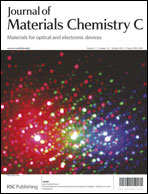Single crystals of CdTeMoO6 have been grown from its stoichiometric melts. CdTeMoO6 is non-hygroscopic and resistant to diluted HNO3 aqua-solution. It is also thermally stable up to 766 °C and thereafter melts congruently. Transmittance spectra of CdTeMoO6 show a broad transmittance window in the range of 345 nm to 5.4 μm. Based upon single-crystal X-ray diffraction analysis, CdTeMoO6 is nonpolar noncentrosymmetric (NCS) and features a neutral layered structure consisting of three types of NCS chromophores, i.e. TeO4 polyhedra with a stereoactive lone pair, distorted MoO4 tetrahedra, and regular CdO4 tetrahedra, the former two being counter-packed and the last one being nonpolar. Such a packing manner of the NCS chromophores is traditionally considered unfavorable to produce strong second-harmonic generation (SHG). However, powder SHG measurements reveal that CdTeMoO6 displays a remarkable SHG effect about 2 times that of polar KTiOPO4 (KTP) at 1.064 μm. The first-principles electronic structure and optical properties calculations have confirmed the presence of a strong SHG effect in CdTeMoO6, and have primarily revealed its origin.

You have access to this article
 Please wait while we load your content...
Something went wrong. Try again?
Please wait while we load your content...
Something went wrong. Try again?


 Please wait while we load your content...
Please wait while we load your content...